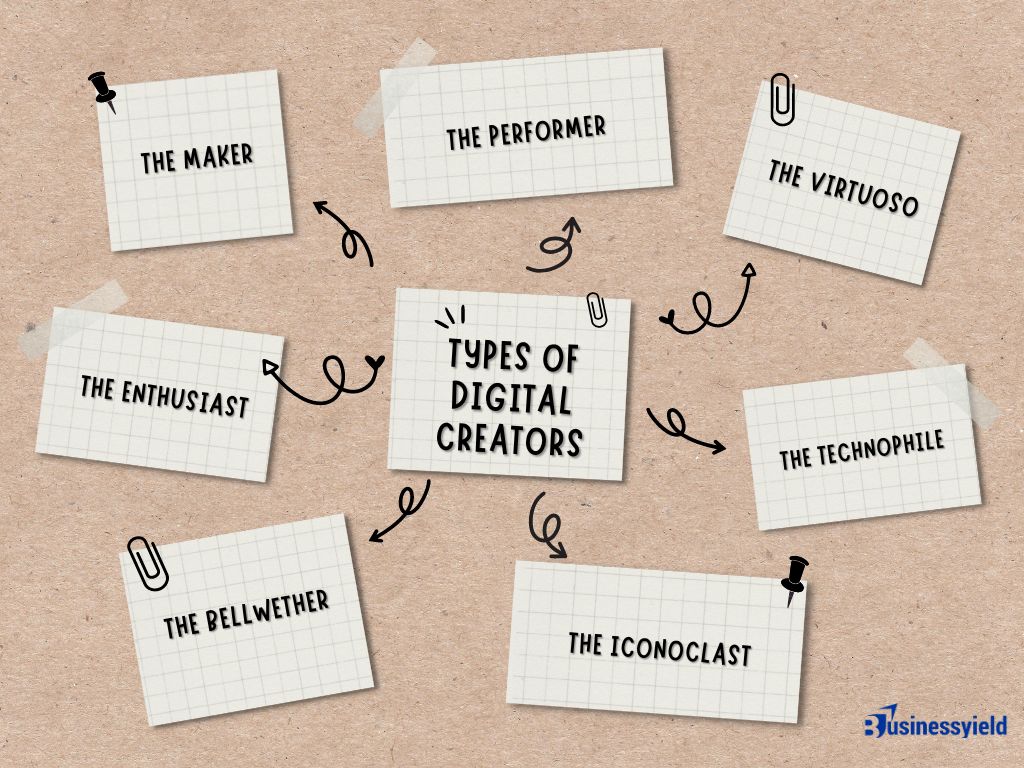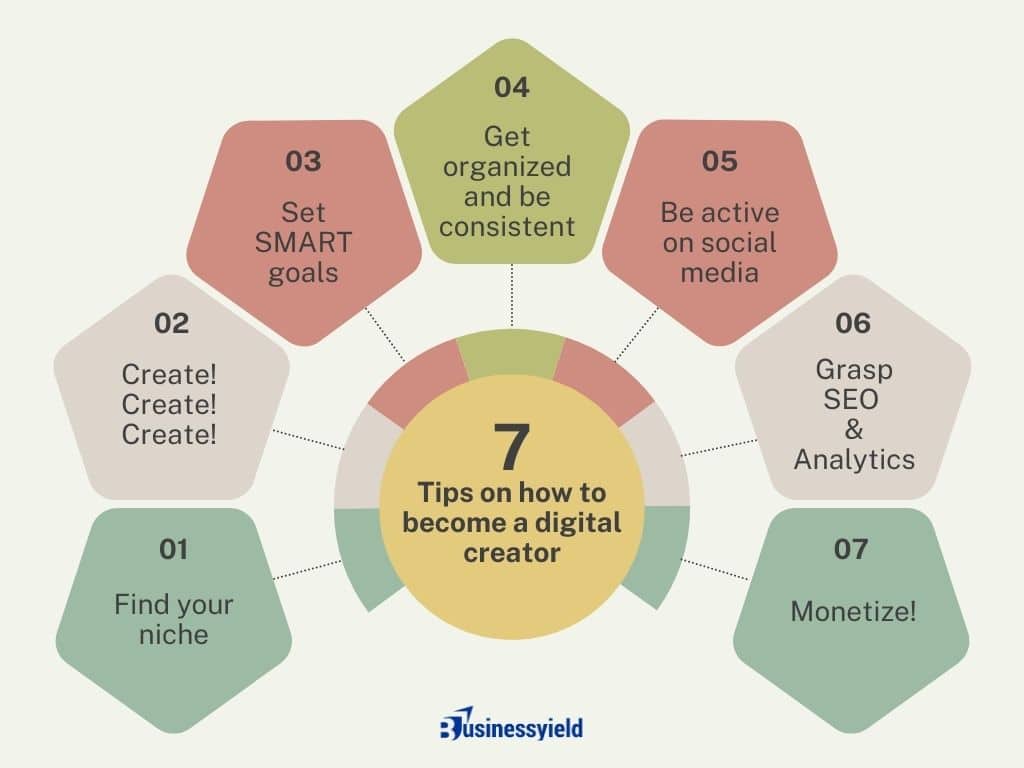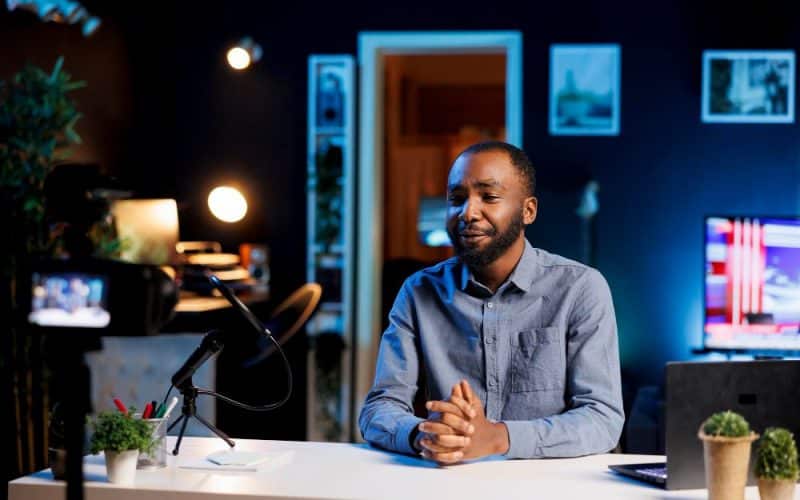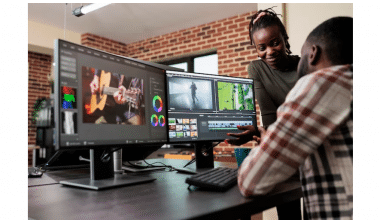I’m sure that, by now, you have definitely heard of the term ‘digital creator’, since it is one of the hottest and most profitable ventures out there right now. And, at a glance, it looks very simple: creating digital content.
But is that all there is to it? Is digital creation nothing more than creating content online? And, if so, is it the same as content creation? Well, without further ado, let’s find out.
Key takeaways
A digital creator is someone who creates content across digital platforms.
As a digital creator, you can earn money from the audience you have cultivated around your content.
Digital creators can be organized by their skills, personalities, and the tech stack they use to create content.
Though the two can overlap, digital creators are not the same as influencers.
Though they are used interchangably, while all digital creators are content creators, not all content creators are exclusively digital creators.
Who is a digital creator?
A digital creator is someone who creates content across digital platforms. The content can be videos, photos, graphics, blog posts, or other forms of media — and the platforms can be YouTube, TikTok, Instagram, Twitter, a website, or any digital space.
The rising popularity of digital creation stems from the numerous opportunities to earn a living. As a digital creator, you can earn money from the audience you have cultivated around your content. Just like I do, because, in case it isn’t clear yet, I am a digital creator. This blog post is an example of digital content.
As digital creators, we focus on building a community of followers, engaging with our audience, and sharing our (often unique) perspectives on a subject. We are often called content creators (more on this later) and we produce content to engage audiences; this can include formats like tutorials, reviews, etc. However, no matter the format of our content, a digital creator must produce high-quality and engaging materials.
Ultimately, that’s our job.
Though the two can overlap, digital creators are not the same as influencers. Influencers are social media personalities whose content is meant to influence their followers to do or buy something. Typically, the influencer earns a percentage from the sale or receives some other incentive. As digital creators, we can influence their audience, but that isn’t the intent of our content. The intent is to educate, entertain, and engage people.
Types of digital creators
Digital creators can be organized by their skills, personalities, and the tech stack they use to create content. Here are seven common types of digital creators, with examples of successful entrepreneurs in each category.

#1. The Performer
Performers are creators skilled in performance arts or on-camera personalities, including comedians, actors, singers, dancers, musicians, DJs, and spoken word poets. Many work in their respective industries, building personal brands in tandem. Others are hobbyists whose work resonates with a niche audience online.
Digital creators of this type can monetize content through Patreon subscriptions, ticketed online stand-ups/concerts, or selling merch through social channels or via an owned website.
Examples of Performer digital creators
- Actor Seth Rogen built his cannabis brand, Houseplant, using his existing celebrity and influencer status to sell to an engaged audience.
- Peyton List launched her beauty brand Pley Beauty to her 1.6 million Twitter followers.
- Comedian and TV writer Ashley Ray diversified her content across social channels, a Substack newsletter, and started a podcast.
- Matt O’Brien’s comedy appears in many formats, from podcasting to social content with monetization on Patreon.
#2. The Technophile
These are the tech-obsessed, including gamers, tech trendsetters, fintech writers, or crypto enthusiasts. They are tuned into the latest gadgets, apps, games, and trends in the tech world at large.
Paid partnerships abound for this group. Successful creators in the tech space can dabble in sponsored content by reviewing or demoing games and products. Technophiles can also sell tickets to live-streaming events, sell merch to fans, or earn money from podcast ads.
Examples of Technophile digital creators
- Top gaming YouTuber and streamer Tyler Blevins is more commonly known online as Ninja. He supplements ad revenue and partnership deals with his owned merch store, Team Ninja.
#3. The Virtuoso
This creator type is made up of professionals and experts in fields including medical, culinary arts, home renovations, sewing, math, wellness, gardening, finance, or fitness. Many of these creators have successful careers in their craft and found that their particular voice or on-camera persona resonated with a wider audience. Some have used their platforms to earn extra income through partnerships or products.
Many creators of this type do brand partnerships, host paid AMAs with a panel of experts, or even self-publish books to sell online to their audiences through owned channels.
Examples of Virtuoso digital creators
- Two real-life OBGYNs, Dr. Jen Gunter and Dr. Nicole, found success debunking wellness myths and creating no-BS health content. Dr. Nicole’s popular TikTok channel drives followers to her website and Dr. Jen creates content across social channels and her podcast and has published two books.
- Many home reno, construction, and interior design experts are tapping into audiences hungry for tips to get pro results with a DIY approach and budget. Jessel and Andrew of The Martinez Casita exploded on TikTok and now monetize their creator work partly through affiliate links on their website.
#4. The Enthusiast
The Enthusiast has crossover with many of the other archetypes and is the broadest. This category includes hobbyists and anyone with a strong interest in a single subject: books, travel, board games, plants, fitness, celebs, pets, art, fashion, etc. The Enthusiast may transition into the Virtuoso by experience and gaining clout through audience and influence.
Because this group is so broad, the monetization opportunities will vary. You can sell products relevant to your interests through an owned channel like a Shopify store, create a VIP tier offering premium content to subscribers, sell online courses, or self-publish books to sell directly to fans.
Examples of Enthusiast digital creators
- Wil Yeung wasn’t a trained chef when he started his YouTube cooking channel. But that didn’t stop him from growing a huge following and monetizing his content with paid courses and a cookbook.
- Sonja Detrinidad dabbled in plants as a distraction from her stressful day job. When she found she had a knack for TikTok, she went all in with her business, Partly Sunny.
- Board game micro-influencer Ella of Ella Loves Board Games has built a small but mighty audience for her niche interest.
#5. The Bellwether
This category is the closest creator type to the classic definition of an influencer. These digital creators grow audiences around their unique tastes or perspectives, most often in fashion, beauty, or pop culture. They spot trends before they explode and, in some cases, launch trends themselves.
This group can find success with brand partnerships. Brands are clamoring to get their products into the hands and feeds of creators who wield massive influence. To have more ownership over your income, start your own apparel or beauty line or sell merch to fans.
Examples of Bellwether digital creators
- Influencer Katie Sturino made a name for herself with body positivity and fashion content, notably, her #SuperSizeTheLook posts that recreate celebrity styles in plus sizes. She leveraged her audience to launch her beauty brand Megababe.
- TikToker MakeUpByTammi shares beauty product reviews and makeup tutorials with an audience of over 500,000. She also runs her own business selling cosmetics through her online store of the same name.
#6. The Maker
The Makers are expert crafters, DIYers, builders, and inventors in several mediums, including woodworking, ceramics, textile arts, jewelry, and tech. Many Makers have found ways to turn their hands-on craft into digital content, building an audience of potential customers.
The most obvious monetization strategy for these creators is selling handmade goods through social selling or an owned channel. Other ideas include selling DIY kits that fans can build alongside your content, or selling DIY courses either live or on demand.
Examples of Maker digital creators
- Creator (or “inventor and evil genius”) Matty Benedetto produces humorous content under the banner Unnecessary Inventions, inventing and demoing completely useless products. While most of his comedic concoctions aren’t for sale, he does sell merch in his online store.
- Ronea sells polymer clay jewelry via timed website “drops” under her brand, Beaded Seed. She cultivated a community around her brand through her TikTok, where she lets fans see inside her process with behind-the-scenes content.
#7. The Iconoclast
The Iconoclast is the artist group of creators making online and offline art across a range of mediums. This archetype describes photographers, videographers, sculptors, painters, street artists, graphic designers, animators, illustrators, filmmakers, art critics, curators, writers, and producers.
Iconoclasts often work as freelancers or independent artists selling work through a personal website or commissioning work for clients. As content creators, they grow art communities around their unique aesthetic.
Like the Maker, this group generally has monetization opportunities in selling digital or physical products like prints, NFTs, or original art. You can also sell courses either live or on-demand to teach techniques, host online or IRL art auctions, or run events bringing together multiple artists.
Examples of Iconoclast digital creators
- New Orleans artist Morgan Gray sells originals and prints on her website while growing a massive following on her TikTok, morganpaintsstuff.
- Ceramicist Tatiana Cordona monetizes her 500,000+ TikTok audience through her accompanying online store, Female Alchemy.
Why are digital creators important?
Ever scrolled endlessly on YouTube or been captivated by an article that popped up on your feed? That’s the magic of us digital creators. Our jutsu, for you Naruto fans. We are behind the engaging videos, riveting articles, and eye-catching graphics that you consume daily.
Here are other reasons why you cannot do without us:
Trendsetting
Digital creators aren’t just content makers; we’re trendsetters. We’ve got their fingers on the pulse of what’s hot and what’s next, often driving the cultural and digital narratives that the public gets wrapped up in.
We introduce a rich diversity of content, from videos to articles, catering to a vast array of audience preferences. This ensures that viewers constantly encounter fresh perspectives and innovative ideas, making the digital space more engaging.
Powering the economy
Digital creators are serious business catalysts. In fact, Statista reports that the global influencer market has grown from $16.4 billion in 2022 to $21 billion in 2023, marking a doubling in size since 2019.
From this, you can see that not only do we generate revenue through avenues like advertisements and partnerships, but we also create job opportunities in sectors like content production and marketing. Our collaborations with brands provide a genuine way for businesses to reach specific audiences, enhancing brand perception and driving sales.
Spotlighting brands
If you’re a brand looking for a voice, digital creators are your go-to. Collaborations with us aren’t just about plastering a logo. It’s about genuine connections, reaching audiences who matter, and dialing up brand love.
Bringing edutainment to the masses
Ever learned a complex concept through a fun video? Or picked up a hobby because of a blog post? Digital creators are bridging the gap between education and entertainment.
We are not just about sharing knowledge, though; we create online communities where like-minded souls connect, discuss, and grow together.
Advocating for meaningful causes
Lastly, many creators use their influence for good, championing social causes and advocating for positive societal change. In sum, digital creators are instrumental in both shaping and reflecting our digital culture, economy, and society.
How to become a digital creator
Becoming a professional digital creator requires a variety of skills and it doesn’t happen overnight. It takes effort and commitment to build a successful brand.
You not only need to be arty and creative and have an interesting insight into your niche, but the most successful creators are highly focused entrepreneurs and business-minded people with well-defined content and communications strategies.
There is no one way to get started as a digital creator, but if you follow the tips below, you can set yourself up for success.

#1. Find your niche
You need to have a clear niche for a couple of reasons. For one, it’ll be hard to attract a loyal audience if your content is too broad because your audience won’t know what kind of content to expect from you. Secondly, a specific niche will help keep you focused and consistent.
If you hit a mental block and you’re not sure how to move forward, you can circle back to your niche to remember why you started creating content in the first place.
#2. Gather the materials you need
Once you know what kind of content you want to make, it’s time to gather the equipment you’ll need, such as a mic, camera, and lighting. Just remember — you don’t have to splurge on the most expensive materials to get started, especially if you’re new to content creation.
Not only is it perfectly fine to use more affordable equipment at the start of your creator journey — but it’s wiser too. You wouldn’t want to spend thousands of dollars on equipment only to realize you don’t enjoy content creation enough to stick with it.
#3. Create
Now you know your niche, understand the kind of content you want to make, and have the right equipment — it’s time to start creating! Don’t be discouraged if your content isn’t perfect at the start. The best way to get better is to keep doing it.
Keep track of your creative process, and take note of what works and what doesn’t. For example, you may find that filming earlier in the day is better than filming in the evening because you get more natural lighting for longer. Whether you’re doing a podcast, posting to YouTube, or blogging, make sure to go back and evaluate your work so you can get better with each post.
#4. Set SMART goals
One of the best ways to improve as a digital creator is to set goals. For example, your goal as a podcaster could be to increase your listenership by 30% in the next year. To help you set proper goals and to keep yourself focused during your creator journey, you should set SMART goals.
SMART goals are:
- Specific, clear and well-defined.
- Measurable and can be tracked with numbers — like the podcaster example.
- Achievable, which requires being honest about what you’re able to get done.
- Realistic and relevant to your overall purpose.
- Timely and includes a target date for the goal to be completed.
SMART goals are more likely to be accomplished because they serve as a road map to achieving your ultimate goal as a content creator — whatever that goal may be for you.
#5. Get organized and be consistent
To keep your audience engaged, they need to know they can expect quality content from you regularly — so it’s important to get on a consistent schedule.
Consider strategies like recording content in batches and scheduling it out over a period of time. For example, you can record five TikTok videos in one day over the weekend and schedule them to post individually over the next week.
When it comes to organization, some digital creators do just fine with physical planners and calendars, but there are also apps and digital tools that can keep you on track. One tool that’s popular among digital creators is Notion — an app that allows you to write, plan, organize your content, and coordinate deadlines all in one place.
No matter what kind of digital creator you are, you must be active on social media to get your work in front of as many people as possible. Being active can be as simple as responding to comments under your social posts.
You should also create graphics, videos, polls, and other unique social media posts to build engagement and communicate with your followers. For example, you can post short clips from your YouTube videos to TikTok or Instagram Reels. You can also create video content for your podcasts to promote a special guest.
#7. Grasp SEO & Analytics
A basic understanding of SEO and analytics can significantly amplify content visibility.
It begins with keyword research to pinpoint terms your audience is actively seeking. Incorporating these keywords naturally into titles, descriptions, and tags can significantly improve content discoverability. Visual elements, such as thumbnails, should be engaging and optimized with relevant keywords in filenames and alt-text.
Furthermore, creators should also be proactive in internal linking, promoting their content ecosystem, and keeping audiences engaged longer.
As platforms update their search algorithms, staying informed and adaptable is crucial. Regularly analyzing performance metrics and refining SEO strategies ensures a steady flow of organic traffic, establishing authority in one’s niche over time.
#8. Take advantage of monetization opportunities
Platforms like YouTube, TikTok, Pinterest, Twitch, and Instagram all have paid opportunities for creators who have a certain number of followers and engagement. Keep track of your progress on these apps to see if you’re eligible or close to being eligible. Other ways to make money as a creator are through brand partnerships, sponsorships, and collaborations.
If brands aren’t reaching out to you organically, then create a press kit that has information about your content, follower count, social media, and engagement —and start reaching out to brands yourself.
Below is a checklist of the steps that you can follow to become a digital creator:
Becoming a digital creator
Skills you need to become a digital creator
Here are some of the most crucial skills you need to be a digital creator:
Creativity
As a digital creator, you need to be creative in everything you do – the clue is in the title!
Creativity includes coming up with new ideas for content, speaking well on camera if you are making a video, and creating eye-catching visuals. You can do this by including thumbnails for videos as well as attractive images on Instagram. You’ll also need to constantly find new ways to engage with your audience, such as with Ask Me Anythings (AMAs) or sharing behind-the-scenes footage.
Communication
Clear communication is key when building a brand and also to progress through your career as a digital creator. You’ll need to be able to clearly communicate your ideas and brand message to your audience so you need strong interpersonal skills and clarity of thinking and speaking.
More business-minded communication is also crucial for professional digital creators; you’ll potentially be having meetings with brand reps and companies looking to work with you or sponsor your content, as well as with other creators you want to collaborate with. Getting your point across concisely and fairly is essential.
Being approachable and adaptable
Some people find it difficult or even painful to listen to feedback. However, you must learn to welcome criticism (especially when it’s constructive!) and use it as an opportunity to improve. Pay attention to your audience’s preferences and adapt your content accordingly.
Consistently evaluate and refine your work to deliver value to your audience.
Digital creator vs content creator
The terms “digital creator” and “content creator” are often used interchangeably, but they can have nuanced differences based on context. Generally, the distinctions are subtle, and the choice of terminology may depend on the nature of the content and the platform used.
A content creator is a broad term that encompasses individuals who produce and share various forms of content. This content can include text, images, videos, audio, and more. Content creators can work in both digital and traditional mediums. For example, a journalist, photographer, or filmmaker could be considered a content creator.
The term “content creator” is often associated with platforms like social media, YouTube, blogs, and podcasts.
A digital creator, on the other hand, is a subset of content creators who primarily focus on creating content in digital formats. This can include digital art, animations, virtual reality experiences, and other forms of media that are inherently digital. Digital creators often leverage technology and digital tools to produce their work. They might use software, digital cameras, graphic design tools, or other digital platforms.
The term “digital creator” may be more specific to those who operate in the online or virtual space, emphasizing the use of digital technology in the creation process.
In essence, while all digital creators are content creators, not all content creators are exclusively digital creators.
In conclusion
The path to digital content creation looks different for everyone, but if you use the above tips to get started, you’ll have an easier time navigating your journey. With proper planning and goal setting, you’ll know the kind of digital creator you want to be and how you can grow over time.
Recommended Articles
- Video Content Creation Strategy
- Building the Future of Work: How Humans and AI Can Collaborate in Content Creation
- CONTENT CREATION TOOLS: Top 10 Content Creation Tools
- Crafting Compelling Content: A Deep Dive into Effective Copywriting Strategies
- The Definitive Guide To 2024’s Content Marketing Strategies: Master The Art, Crush The Competition
- Creating Valuable Content For Affiliate Marketing: A beginner’s guide
- 5 Steps to Crushing Your Competition with Content Strategy






